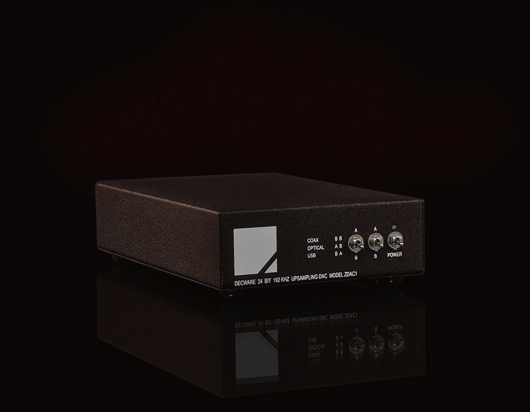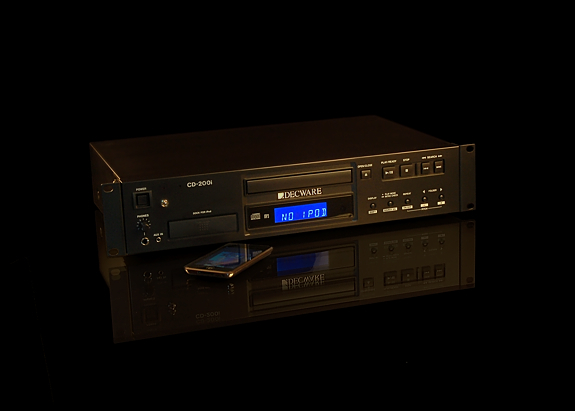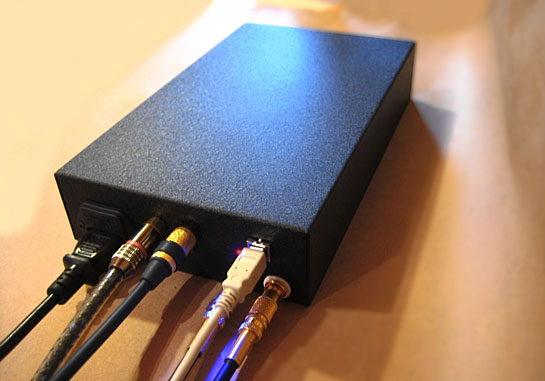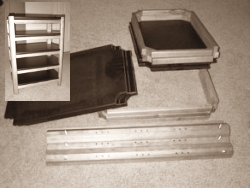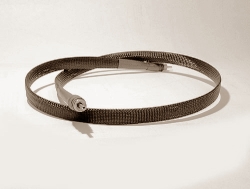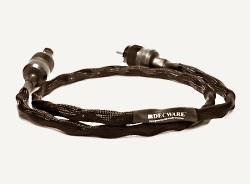ZDAC-1
OVERVIEW
The ZDAC-1 is an
audiophile
implementation Cirrus
Logic's flagship 192kHz multi-bit CS4398 DAC Chip. It features Coax, Optical
and USB inputs via a digital
receiver with 32kHz~192kHz sample
frequency range and low-jitter clock recovery. All three inputs,
including USB are up-sampled to 24-bit/192kHz and are
selectable
from
the front switches. The
output stage features high grade op amps that have been carefully
voiced for each channel to handle the I/V conversion from the DAC chip
to the dual-mono buffer stage for a nice low output impedance.
|

"The
low end through the ZDAC was so tight, taut and deep that it actually
bottomed out the 5" woofers of the DeVore speakers, something none of
the other DACs achieved. Then again perhaps that’s a design flaw of
some sort. I don’t know. But the ZDAC’s low end was excellent, gutsy,
tight and had plenty of snap and power. Petty’s "Working Man’s Bible"
presented excellent snap on Ferrone’s snare drum and cymbal spread was
brilliant. The Sco disc reveled in a similarly large hall ambience.
The
Z-DAC presented a very warm, flowing rich presentation of all discs. I
dug it the most. Not as super resolving as the Moon, it presented an
organic almost analog sound. Its voicing seemed centered on the
midrange, a glorious midrange. I loved its tonality, its ability to
isolate instruments yet thread them together into a concise coherent
whole. Definitely first row. Baritone sax and bass drums on the
Scofield disc had real bite, juiciness and succulence. You could lick
the sounds coming out of this black box. It didn’t present a very large
soundstage but it did exact a meaty vision that was very immediate,
palatable and true. Sco’s guitar also had funky body and strings
sounded rich. Drums exhibited punch and attack. Tactile touch-i-ness.
Food
sounded almost flat in recording studio terms as though a veil had
lifted. Even at lower volumes music was warm and exciting. The Z-DAC
got the better of me. It made me forget about the review I had to write
and simply partake of the music. But back to work, there was one more
challenger."
You can read the whole review here.
|
THE DESIGN GOAL
For
ten years we've been hearing "When is Decware going to come out with a
DAC?" The answer has always been the same: "When we can make one
as impressive for the dollar as the rest of our products".
That means it has to sound better than dacs competing in the same price
window...
and we don't need to tell you how many DAC's there are out there.
Admittedly this is why it's taken so long.
The R&D was a top down process that was about
reaching a cost no object reference first. After trying a multitude of
different approaches we ended up with a 16 bit non-oversampling machine
pictured below. Projected cost close to $6,000.00
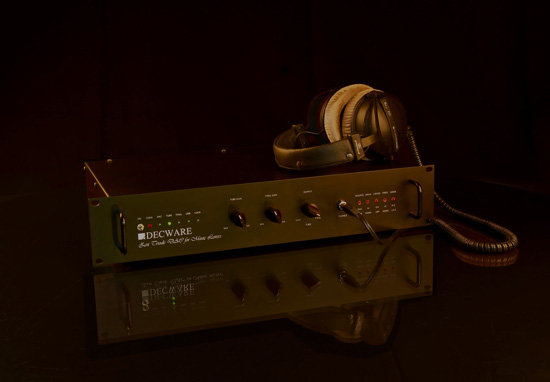
From that point forward the challenge became about designing something
that would sonically compete in a way that people could afford.
The reference dac pictured above combined a Tube gain stage
and a solid state gain stage with buffer that could be listened to in
any combination. Some nights I prefer the sound of the dac by
itself, and sometimes I like to add the tube stage and most of the time
I use all the stages. Obviously since the dac sounds rather great
by itself, many people suggested just building that and making the
remaining stages optional.
Fast forward to the end result shown below, and it
accomplishes very similar results with three separate matching
components. The main component, the ZDAC-1 shown in the middle of the
trio, can optionally be supplemented with a single-ended triode class A
tube gain stage (left of the dac) and in some systems can benefit
further from adding our SET class A tube buffer, called the ZBOX (right
of the dac). All three components together come in at or below
$2000.00 and since this is a 32 bit machine that re-clocks and
up-samples
everything you feed it to 24bit/192kHz with minimal oversampling, it
actually surpassed our reference dac in several categories.
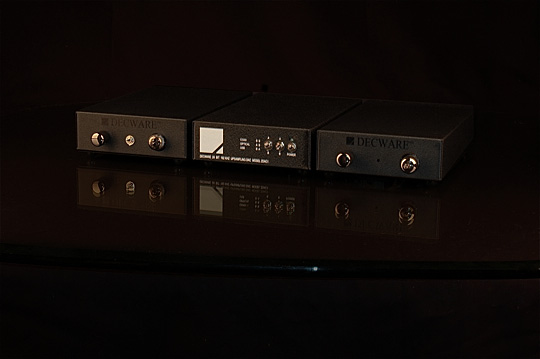
In this trio, the ZDAC-1 sounds so good that most people after hearing
it will never consider adding either of the two matching stages and
that is exactly what we wanted! This is not a scenario where you
need all three units to have a reference quality playback, so you need
not feel inferior for listening to just the DAC. The optional units
don't bring better sound quality to the table, but rather more in-depth
control of the playback giving neurotic audiophiles something they can
use to manipulate recordings for more pleasing sound.
-Steve Deckert
ABOUT USB
The ZDAC-1 will accept 16/44 and 24/96 bit data from
your computer on it's USB port. 16/44 and 24/96 files will
be up-sampled to 24/192 automatically. USB connectivity was not
an afterthought in this dac and consequently USB will usually sound
better than COAX or OPTICAL unless you have a great transport and
cables.
With a computer you can rip CD's that are checked against
online databases for accuracy. This means you can get a
bit-for-bit perfect recordings with zero errors - this is difficult to
achieve even with brand new CD's on the very best transports. You
can also play hi-res CD's and DVD's done at 24/96 or higher resolutions
using a computer, or just fill your home with music during the day by
streaming internet radio to your ZDAC-1. Even MP3's and ITunes
purchases will sound better than ever because regardless of the
resolution, everything is up-sampled to 24bit 192kHz for a smoother
more
detailed almost analog sound.
The USB input is compatible with Windows
XP/Vista, Mac OS,
Linux. No drivers are needed, just plug n'
play.
OPTIONS
Internally the ZDAC-1 is well endowed with audiophile
parts. Packed with mil spec resistors, Nichicon Muse caps, LT1361
output stages and Burr Brown buffers there isn't anything inside that
you would want to change.
ZSTAGE - Matching tube gain stage
for the ZDAC-1 will add some tube goodness to the picture.
ZBOX - Matching tube buffer stage for
the ZDAC-1 will further bloom things up, especially with 16 bit
recordings or MP3's.
DHC-1 Our power cord can be
used with all of these items.
FEATURES:
Digital inputs: 1-Coaxial, 1-Optical, 1-USB
(Windows XP/Visa, Mac OS, Linux compatible)
Inputs selectable from the front panel.
USB is plug and play, no drivers needed. Compatible with 1.0 and
2.0 USB standards.
Removable power cord with high-end IEC connector
Analog outputs: 2- Gold/Teflon RCA jacks
CS4398 24 bit 192kHz DAC chip - 120dB dynamic range with -107dB
THD+Noise.
Digital receiver CS8416 with low-jitter recovery clock
CS8421 up-sampler
Dual LT1361 output stage with Burr Brown followers
Nichicon MUSE caps, WIMA, Rubycon as well as mil spec 1% resistors used
everywhere.
Front panel LED indicates on/off.
Rear panel LED lights when USB is connected to computer.
The ZDAC-1
6 inches wide, 10 inches deep (not including jacks) and 2.5
inches tall)
is available in 110/120V and 220/240v.
SUPPORT
This
unit is built in the USA by
DECWARE / High Fidelity Engineering Co. It comes with a one year
warranty to the original owner.
We also
have a support
forum
for this product.
REVIEWS
You may
read reviews
on
our
products going back 10
years.
HISTORY
of
REVISIONS
None. The ZDAC-1 is new in April 2010
SPECIFICATIONS
| Weight |
|
7 lbs. ea. |
| Dimensions |
|
2.5" H x 6"
W x 10.5" D |
| Output |
|
1.8 volts |
| Output Impedance |
|
< 100
ohms
|
| Noise / Hum |
|
-107dB |
| Response |
|
20 Hz ~ 20 kHz |
RELATED
INFO
ZDAC-1 Owners Manual
|
![]()
